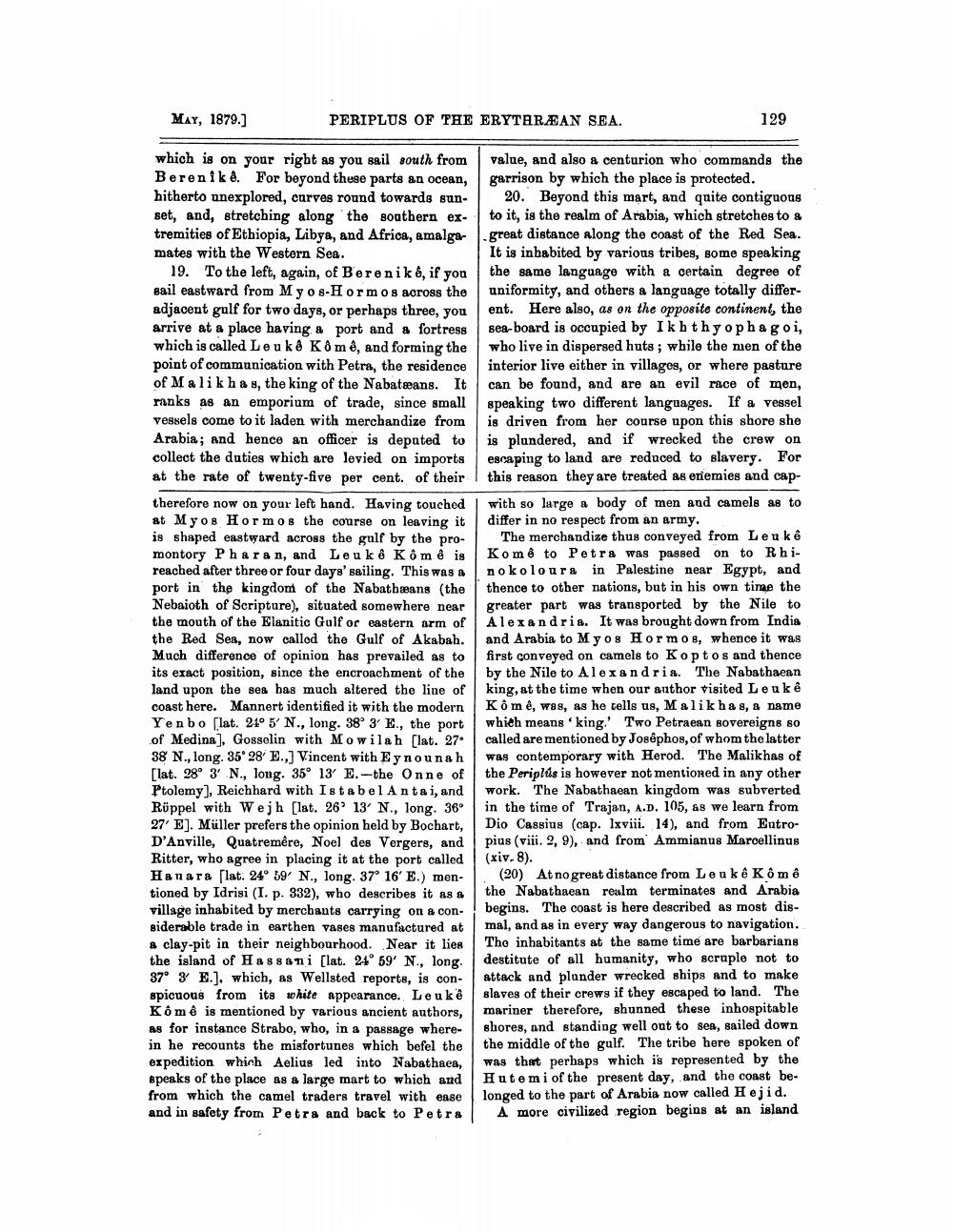________________
MAY, 1879.]
value, and also a centurion who commands the garrison by which the place is protected.
20. Beyond this mart, and quite contiguous to it, is the realm of Arabia, which stretches to a
which is on your right as you sail south from Berenike. For beyond these parts an ocean, hitherto unexplored, curves round towards sunset, and, stretching along the southern extremities of Ethiopia, Libya, and Africa, amalga-great distance along the coast of the Red Sea. mates with the Western Sea. It is inhabited by various tribes, some speaking the same language with a certain degree of uniformity, and others a language totally different. Here also, as on the opposite continent, the sea-board is occupied by Ikhthyophagoi, who live in dispersed huts; while the men of the interior live either in villages, or where pasture can be found, and are an evil race of men, speaking two different languages. If a vessel is driven from her course upon this shore she is plundered, and if wrecked the crew on escaping to land are reduced to slavery. For this reason they are treated as enemies and cap
PERIPLUS OF THE ERYTHREAN SEA.
19. To the left, again, of Berenike, if you sail eastward from Myos-Hormos across the adjacent gulf for two days, or perhaps three, you arrive at a place having a port and a fortress which is called Leukê Kômê, and forming the point of communication with Petra, the residence of Malik has, the king of the Nabateans. It ranks as an emporium of trade, since small vessels come to it laden with merchandize from Arabia; and hence an officer is deputed to collect the duties which are levied on imports at the rate of twenty-five per cent. of their
therefore now on your left hand. Having touched at Myos Hormos the course on leaving it is shaped eastward across the gulf by the promontory Pharan, and Leukê Kôme is reached after three or four days' sailing. This was a port in the kingdom of the Nabathæans (the Nebaioth of Scripture), situated somewhere near the mouth of the Elanitic Gulf or eastern arm of the Red Sea, now called the Gulf of Akabah. Much difference of opinion has prevailed as to its exact position, since the encroachment of the land upon the sea has much altered the line of coast here. Mannert identified it with the modern Yenbo [lat. 24° 5' N., long. 38° 3' E., the port of Medina], Gosselin with Mowilah [lat. 27. 38 N., long. 35° 28' E.,] Vincent with Eynounah [lat. 28° 3' N., long. 35° 13' E.-the Onne of Ptolemy], Reichhard with Istabel Antai, and Rüppel with Wejh [lat. 26' 13' N., long. 36° 27' E]. Müller prefers the opinion held by Bochart, D'Anville, Quatremêre, Noel des Vergers, and Ritter, who agree in placing it at the port called Hanara [lat. 24° 59′ N., long. 37° 16' E.) mentioned by Idrisi (I. p. 332), who describes it as a village inhabited by merchants carrying on a considerable trade in earthen vases manufactured at a clay-pit in their neighbourhood. Near it lies the island of Hassani [lat. 24° 59' N., long. 37° 3 E.], which, as Wellsted reports, is conspicuous from its white appearance. Le u kê Kômê is mentioned by various ancient authors, as for instance Strabo, who, in a passage wherein he recounts the misfortunes which befel the expedition which Aelius led into Nabathaea, speaks of the place as a large mart to which and from which the camel traders travel with ease and in safety from Petra and back to Petra
129
with so large a body of men and camels as to differ in no respect from an army.
The merchandize thus conveyed from Leukê Komê to Petra was passed on to Rhinokoloura in Palestine near Egypt, and thence to other nations, but in his own time the greater part was transported by the Nile to Alexandria. It was brought down from India and Arabia to Myos Hormos, whence it was first conveyed on camels to Koptos and thence by the Nile to Alexandria. The Nabathaean king, at the time when our author visited Leukê Kô mê, was, as he tells us, Malik has, a name which means 'king.' Two Petraean sovereigns so called are mentioned by Josephos, of whom the latter was contemporary with Herod. The Malikhas of the Periplús is however not mentioned in any other work. The Nabathaean kingdom was subverted in the time of Trajan, A.D. 105, as we learn from Dio Cassius (cap. lxviii. 14), and from Entropius (viii. 2, 9), and from Ammianus Marcellinus (xiv. 8).
(20) At no great distance from Leukê Kômê the Nabathaean realm terminates and Arabia begins. The coast is here described as most dismal, and as in every way dangerous to navigation.. The inhabitants at the same time are barbarians destitute of all humanity, who scruple not to attack and plunder wrecked ships and to make slaves of their crews if they escaped to land. The mariner therefore, shunned these inhospitable shores, and standing well out to sea, sailed down the middle of the gulf. The tribe here spoken of was that perhaps which is represented by the Hutemi of the present day, and the coast belonged to the part of Arabia now called Hejid. A more civilized region begins at an island




